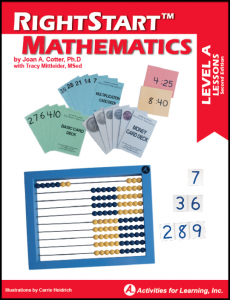RightStart Math
I personally spent lots of time as a new homeschool mom looking at math programs. Math is not a subject that should involve hopping through different programs. Each curriculum has its own method and madness, and too much change can create confusion.
So, we started off with RightStart Math, and it has worked! I did hit some moments of uncertainty with my older daughter (who is now studying Algebra), but as I am going through the program with my second daughter, I am seeing the sequence more clearly. My favorite parts are the games included in the lessons, the “short and sweet” worksheets, the simple lessons, and the teacher’s guide of what to say and do.
If your student is 4 years old or younger, you probably don’t want to start a formal math program. There are so many other fun things that you can do to integrate math! You are mainly wanting to establish the relationship between the words and the symbols (numbers, colors, shapes). Click here for a few ideas.
As you move from recognition of the math symbols into relationships between the symbols (i.e. addition, subtraction), you may want to start looking for a math program. If you want something more structured like school textbooks, you may want to check out Saxon Math, or for something more visual and interactive, explore the Math U See program. There are many options out there, and I encourage you to find the one that makes the most sense to you as a teacher. RightStart Math is easy for me to teach. You can always adjust your curriculum to fit your child, but it is harder to explain something that you can’t even understand yourself!!!
This is one area where I encourage you to beg or borrow a friend’s program and try a few lessons before you make a purchase. Math curriculums and manipulatives are quite expensive. If you don’t have a friend, attend a few homeschool conventions and visit every elementary math booth in the curriculum hall. Let them give you their presentation and touch and browse through the books thoroughly. This is great fun for you shoppers!

